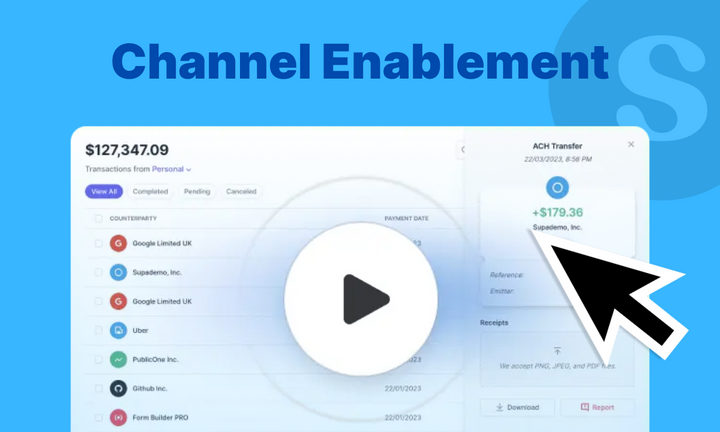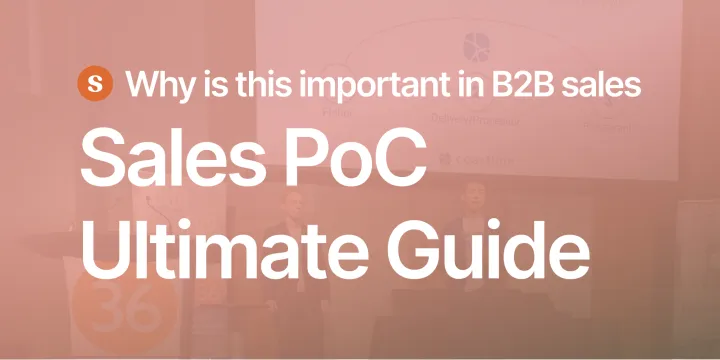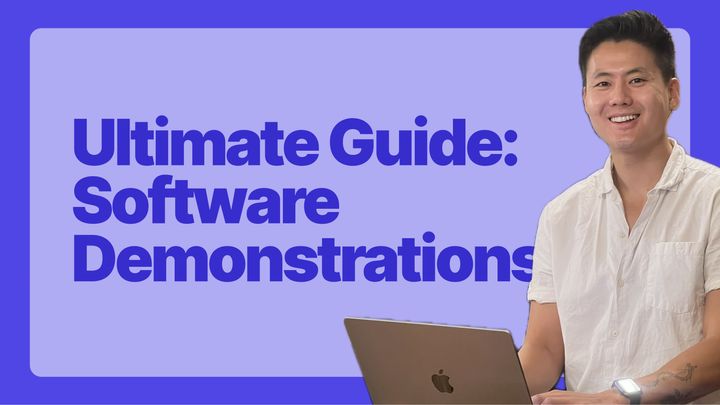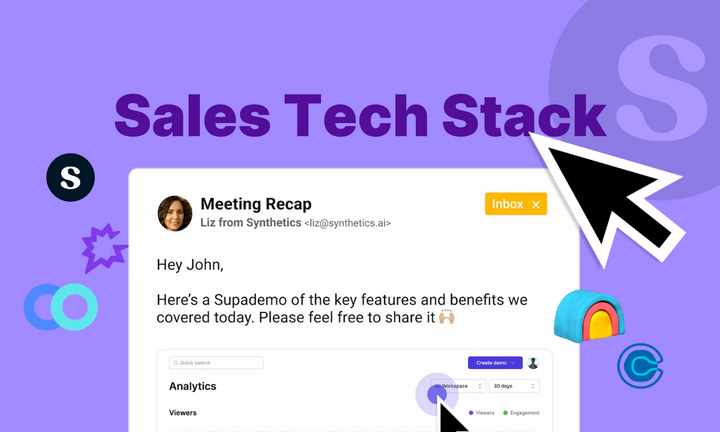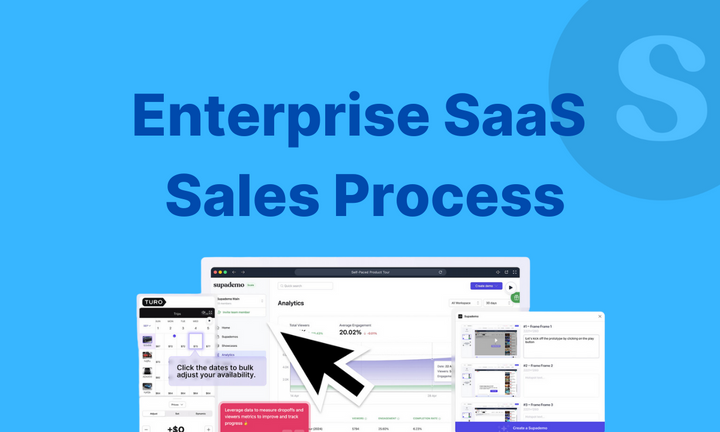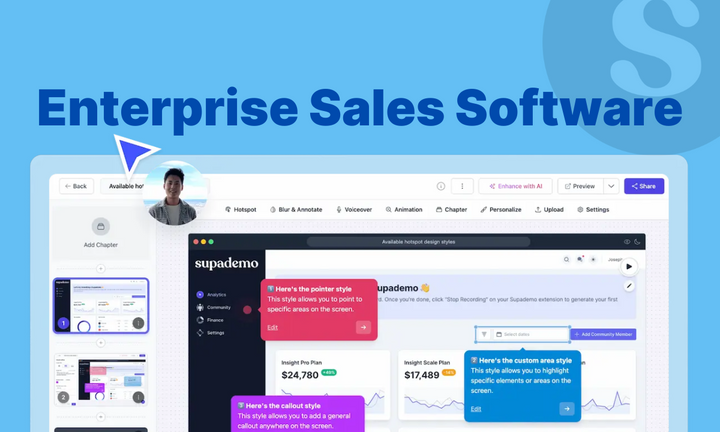The fastest-growing B2B companies have cracked the code on channel enablement. When done right, it turns your ecosystem into a revenue engine that scales faster and reaches further than direct sales alone.
Here's the truth: partners won't go to battle for you unless you give them the right weapons—and show them how to use them.
When you nail channel enablement, partners don't just resell your product. They champion it. They educate prospects, handle objections, and close deals—sometimes better than your own reps.
This guide shows you how to build a channel enablement engine that actually drives results.
TL;DR
• What real enablement looks like (spoiler: it's not just training videos)
• How to find and activate high-impact partners
• The toolstack modern GTM leaders rely on to scale programs fast
• Why Supademo is becoming the secret weapon in partner onboarding and sales acceleration
What is channel enablement?
Channel enablement, in plain terms, is giving your partners everything they need to sell like your top reps.
We're talking about the full stack: product knowledge, messaging, positioning, competitive intel, and sales tools—packaged in a way that's simple to use and easy to act on.
Because here’s the brutal truth: partners aren’t sitting around waiting to sell your product. They’ve got a dozen others in their bag. If you’re not making it effortless and lucrative for them to sell yours, they’ll move on.
Quick litmus test:
• If a partner logged into your portal right now, could they:
• Understand your core value prop in under 60 seconds?
• Find an up-to-date interactive demo or pitch deck without hunting through dead links?
If not, you’ve got work to do.
Done right, enablement transforms partners from passive participants into active, quota-carrying allies. It’s not a cost center. It’s one of the most leverageable investments you can make to grow pipeline without adding headcount.
Next, we’ll break down exactly why this matters more than ever in today’s market—and how to get it right.
Why channel enablement matters
Let’s cut through the fluff: your partners aren’t just a route to market—they’re an extension of your brand, your value prop, and your customer experience.
If they don’t get your product, they won’t sell it. If they don’t believe in it, they won’t prioritize it. And if you’re not enabling them properly, they’ll rep your competitors better than they rep you.
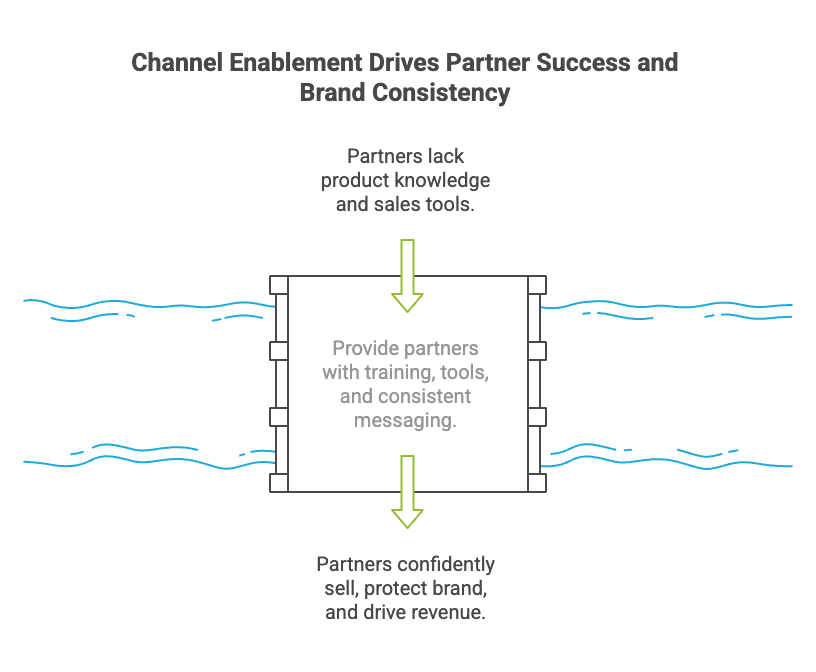
Here’s why real channel enablement is a non-negotiable:
1. It sharpens product understanding
Your product might be the best in the market, but if your partners can't explain it clearly and confidently, you're sunk. Channel enablement gives them the clarity, context, and conviction to talk about your product like they built it.
2. It makes selling easier
When you arm partners with ready-to-use tools—interactive demos, pitch decks, objection handlers, value calculators—you remove friction. You're not just educating them, you're accelerating their sales cycle through sales enablement content.
This is exactly where tools like Supademo come in. Instead of guessing how to pitch, partners can walk prospects through polished, interactive product tours that do the heavy lifting.
Here's an example demo of Canva built using Supademo -
3. It protects your brand
A partner’s pitch is often the first real touchpoint with your future customers. If it’s off-message, outdated, or inconsistent, you’ve already lost credibility. Enablement ensures every partner sounds like your best AE—on brand, on message, and on point.
4. It drives real pipeline
Let’s be real: when partners are confident, equipped, and supported, they sell more. Not “maybe.” Not “eventually.” They. Close. Deals.
And they don’t churn. Enabled partners stick around longer, grow faster, and become advocates inside your channel program. That’s how you build long-term, compounding revenue—not churn-and-burn activity.
Finding the right partners
Here’s a hard truth: most partner programs fail not because enablement is bad—but because they onboard the wrong partners to begin with.
Stop recruiting based on logos, headcount, or how many badges they’ve got on LinkedIn. That stuff looks good in a slide deck but means nothing in the field.
What actually matters?
1. Strategic fit over surface flash
A partner with 500 employees who’s half-committed will never outperform a 10-person team who’s all-in. Choose partners who actually want to grow with you, not ones who just want to add you to a portfolio.
You’re not looking for trophy logos. You’re looking for alignment:
➡️ Do they sell to your ICP?
➡️ Do they get your product’s core value?
➡️ Will they pick up the phone when you call?
2. Know your Ideal Partner Profile (IPP)
Just like your sales team builds an Ideal Customer Profile (ICP), your channel team needs an IPP.
Ask yourself:
➡️ Do they already sell complementary solutions?
➡️ Are they technical enough to onboard customers—or will they lean on your CS team?
➡️ Can they generate net-new leads or just fulfil demand?
Plot it out. Be ruthless. Not every partner deserves a seat at the table.
3. Vet for motivation and motion
A partner’s why matters. Why do they want to sell your product? Are they chasing MRR, solving a customer need, or just testing the waters?
Then check the motion:
➡️ Do they already have a GTM process?
➡️ Do they run regular campaigns or events?
➡️ Do they have sellers who can actually close?
Because if all they’re offering is a logo and a promise to “introduce you to their network,” you’re wasting time.
4. Start small, scale smart
Test before you invest. Give new partners a pilot region or vertical. Equip them with your top-performing Supademos, one solid deck, and a battlecard—and watch how they move.
Track activity. Measure conversion. Follow up. Treat them like reps. If they deliver, invest more. If they ghost, cut fast.
How to build a channel partner program
Let’s get something straight: a channel partner program isn’t a partnership directory. It’s a growth engine. But to get it firing, you need clarity, structure, and execution.
Here’s how to build one that doesn’t just exist—it performs.
Step 1: Choose the right model for your motion
Not all partnerships are created equal. Before you onboard anyone, get clear on what role you want your partners to play.
| Partnership Type | Who it's for | How it works | Pros & Cons |
|---|---|---|---|
| Affiliate | Low-touch, high-volume products | Partners refer traffic or leads via a trackable link. You pay per lead or conversion. |
Pros: Scalable, easy to manage Cons: Low control over quality. Better suited for B2C or PLG |
| Referral | Complex sales, high-trust networks | Partners introduce warm leads. Your team closes. Partners earn a cut. |
Pros: High-quality leads, strong relationships Cons: Slower to scale, requires consistent engagement |
| Reseller | SaaS with complex onboarding or global/local expansion needs | Partner owns the full sales cycle and customer relationship |
Pros: Broad reach, scalable GTM Cons: Heavy training and support required |
Step 2: Set clear entry criteria
Don’t let just anyone in. Define what a qualified partner looks like based on:
➡️ Sales readiness (do they have reps who can actually sell?)
➡️ Customer base (do they touch your ICP?)
➡️ Technical capability (can they handle onboarding and sales enablement tools, or will you be holding the bag?)
Publish your criteria. Use it to screen ruthlessly. If you onboard the wrong partners, enablement won’t save you.
Step 3: Make enablement a non-negotiable
If partners don’t know what to sell, how to sell it, or where to find the pitch deck—your program is dead in the water.
This is your channel enablement playbook:
➡️ Give every new partner a zero-friction onboarding sequence.
➡️ Embed Supademo walkthroughs so they can self-educate and demo without waiting.
➡️ Deliver bite-sized training: feature tours, positioning videos, use case decks.
➡️ Create a Partner Hub with always-fresh assets, not outdated PDFs from 2021.
Step 4: Track performance, aggressively
Every partner should have a dashboard. You should know:
➡️ Who’s driving pipeline
➡️ Who’s closing
➡️ Who’s ghosting your leads
➡️ Which assets and Supademos are actually getting used
➡️ Don’t manage partners by gut feel. Manage them like a sales team—by numbers.
Step 5: Build trust through proactive communication
The best programs have high EQ and high accountability. Keep communication tight:
➡️ Monthly check-ins (not just QBRs)
➡️ Real-time deal support
➡️ Fast answers, fast feedback loops
Recognize top performers. Fire the inactive ones. Make it clear: this is a program, not a parking lot.
Tools to Make Channel Partnerships Easier
| Tool | What It Does | Why It’s Useful |
|---|---|---|
| Supademo | Lets you create interactive, self-guided product demos. Features include branching paths, analytics, custom branding, and easy sharing. | Makes onboarding faster, helps partners deeply understand your product, and gives visibility into what’s landing with prospects. |
| Seismic | Centralized platform to manage, personalize, and distribute sales and training content. | Ensures partners always have the most current materials, reducing version chaos and messaging drift. |
| Canva | Drag-and-drop platform for creating co-branded, marketing-ready visual assets. | Empowers partners to design polished, on-brand campaigns without creative bottlenecks. |
| PartnerStack | End-to-end partner management platform to recruit, onboard, pay, and track partners. | Automates partner ops and gives visibility into deal flow, commissions, and engagement. |
| Gong | Conversation intelligence tool that captures and analyzes sales calls and demos. | Helps identify how partners pitch, where they fumble, and what winning ones do differently. |
| Kiflo | Purpose-built PRM for startups and SMBs to manage partner lifecycle—from onboarding to deal registration. | Simple, affordable, and effective for scaling early-stage partner programs without enterprise bloat. |
Working towards great partnerships
Trust that your partners are putting in the work. Trust that you’re giving them the tools to win. And trust that when one side wins, so does the other.
This is where great enablement becomes more than a channel enablement strategy. It becomes a signal. It tells your partners: We’re investing in you because we believe in the value you can deliver.
Build the relationship, not just the revenue
The strongest partnerships are grounded in:
Clarity: Partners know exactly how to pitch, who to target, and what’s expected.
Support: Your team is responsive, helpful, and proactive.
Enablement: They’re not guessing. They’re trained, equipped, and confident.
When you consistently deliver on those three pillars, your best partners double down. They prioritize you. They close more deals. They bring you into opportunities early—and lock out competitors before they’re even mentioned.
Long-term growth starts with high-leverage enablement
If you're serious about building a channel that doesn't just exist but thrives, the playbook is clear:
➡️ Pick partners with precision.
➡️ Invest in sales enablement like it's part of your sales org.
➡️ Use tools that reduce friction and increase clarity.
➡️ Make it easy to learn, pitch, and sell—with Supademo tools.
You don’t need 100 partners. You need the right 20—enabled, trusted, and aligned.
Give them what they need to win, and they’ll take you further than your direct team ever could.
Supademo makes enablement frictionless
Let’s be real. Most vendors talk about enablement, but the experience for partners is clunky and outdated.
Supademo changes the game by making learning, selling, and sharing your product interactive, intuitive, and instant.
Partners onboard faster because they can learn on their own time, in their own flow.
They pitch better because they have product demos that speak for themselves.
You scale faster because you’re not chasing down every “Can I get the latest pitch deck?” request.
FAQs
What is a channel enablement strategy and why is it important?
A channel enablement strategy is a structured plan to equip partners with tools and training to sell effectively. It drives revenue growth through aligned execution.
How does channel enablement differ from partner enablement?
Channel enablement focuses on sales execution; partner enablement includes broader lifecycle support like onboarding and support.
What are the key components of an effective channel enablement program?
The key components of an effective channel enablement program are clear onboarding, sales training, content access, performance tracking, and responsive support.
How can organizations measure the success of their channel enablement efforts?
Track partner-sourced pipeline, win rates, engagement with enablement assets, and activation velocity.
What are the best practices for implementing a channel partner enablement strategy?
Start with high-fit partners, use scalable tools, deliver actionable content, and measure everything.
How do channel enablement tools support partner onboarding and training?
They make learning self-serve, trackable, and repeatable—reducing dependency on live support.
How can technology improve the scalability of channel enablement initiatives?
It automates delivery, personalizes content, tracks usage, and reduces manual touchpoints.
What challenges do companies face when rolling out a channel partner enablement program?
Lack of engagement, inconsistent messaging, poor content access, and low partner accountability.
How can businesses choose the right channel enablement tools for their ecosystem?
Pick tools that are easy to use, integrate into your stack, and directly support partner outcomes.


